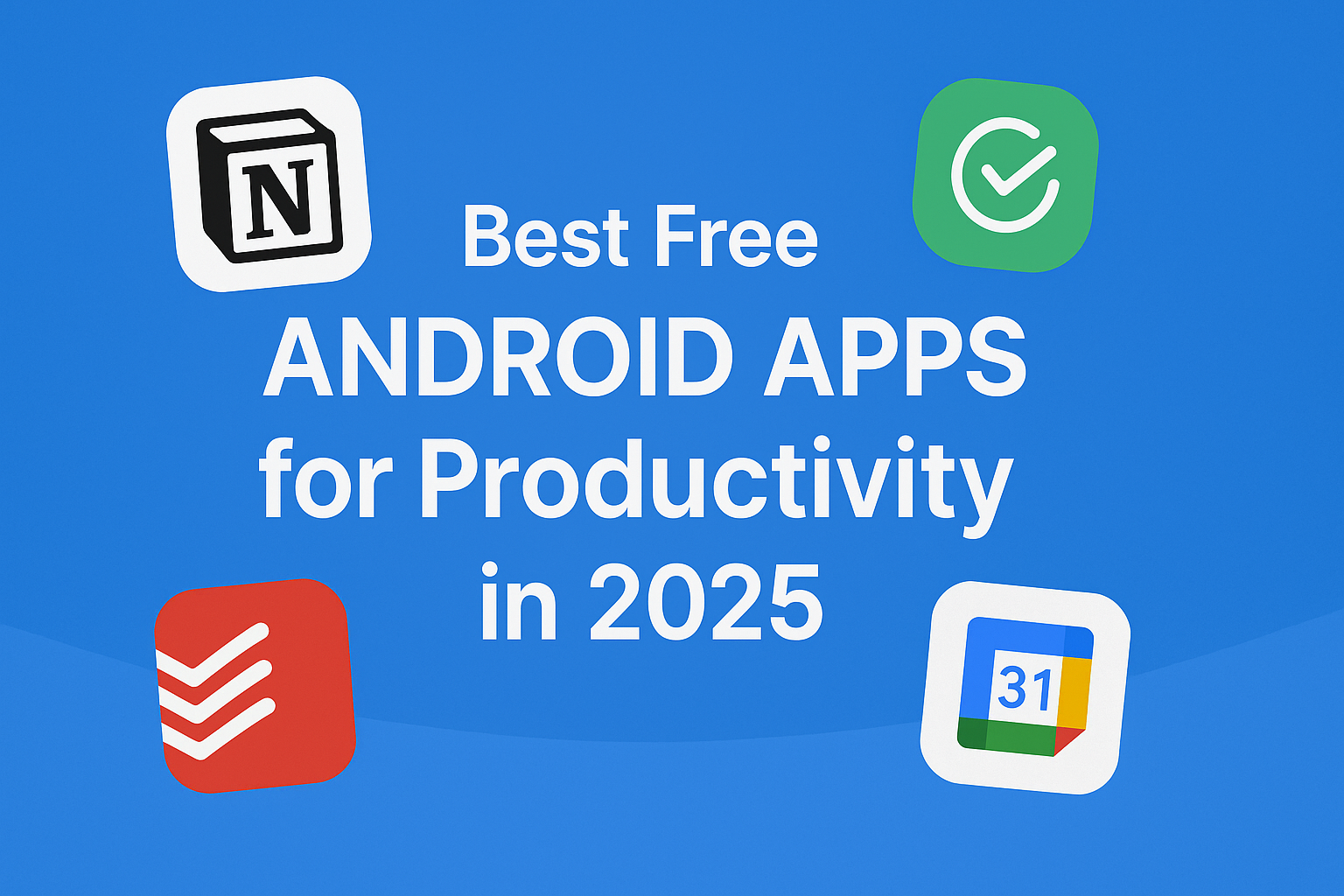If your Android phone is where your day starts and ends, the right apps can feel like a superpower without costing a cent. Below is a carefully curated, 100% free-to-use lineup of the best productivity apps for 2025. I’ve focused on tools that are fast, reliable, and generous on their free plans, and I’ve noted any key limitations so there are no surprises later.
How we chose
- Truly useful free tiers (not just 7-day trials).
- Cross-platform sync where it matters.
- Privacy & reliability (bonus points for open-source).
- Clear, focused workflows—not feature bloat.
1) Notion — the all-in-one workspace
Notion’s free plan is more than enough for personal productivity, allowing you to create pages, databases, and linked views to manage tasks, notes, and projects in one place. It’s flexible, fast on Android, and great for light collaboration. You can start free and expand only if you need advanced features later.
2) Todoist — fast, flexible task management
Todoist remains a favorite because it strikes a balance between simplicity and power, offering natural-language dates, priorities, labels, and clean views for Today and Upcoming. The free plan is “free forever,” which is perfect for personal task lists and small projects.
3) Microsoft To Do — tasks that sync with Outlook
If your world already runs on Microsoft 365, To Do is a no-brainer. It’s free, syncs across devices, and integrates with Outlook tasks so everything lives in one list. The Android app is polished and continues to get meaningful updates.
4) Google Keep — the quickest way to capture anything
For fast notes, lists, voice memos (with transcription), and photo notes that sync everywhere, Keep is the lightweight champ. It’s simple, collaborative, and tightly integrated with Google Workspace.
5) Obsidian — a free “second brain” you actually own
Prefer local Markdown notes with serious power? Obsidian Mobile (free) mirrors the desktop app, supports plugins and themes, and stores your notes as plain text, great for longevity and portability. Sync is optional (and paid), but the core app is full-featured for free.
6) Joplin — open-source notes with end-to-end encryption
Joplin is a privacy-first note-taking and to-do app with end-to-end encryption (E2EE) across platforms. It’s open-source, Markdown-friendly, and ad-free—ideal if you want full control of your data.
7) Google Calendar — time blocking plus built-in tasks
Calendar remains the most reliable free scheduler on Android, with solid Gmail parsing for events and smooth cross-device sync. Google has improved task visibility inside Calendar on mobile, making it easier to manage your day from one screen.
8) Trello — kanban simplicity for solo or team projects
Trello’s free plan still gives you a lot: unlimited cards, up to 10 boards per workspace, mobile apps, and essential automation. It’s a friendly way to track work from idea to “done” with lists, labels, due dates, and views like Calendar and Timeline.
9) TickTick — tasks + calendar + Pomodoro + habits
If you like everything under one roof, TickTick’s free tier blends to-dos, multiple calendar views, basic habit tracking, and built-in Pomodoro timers. It’s polished, fast, and works across devices.
10) Loop Habit Tracker — private, open-source habit building
Loop is an ad-free, open-source habit tracker with beautiful charts and zero fluff. It’s perfect for daily routines, streaks, and long-term consistency—without nagging subscriptions.
11) Automate (LlamaLab) — powerful Android automation
Automate lets you build flows (think: “if this, then that”) using visual blocks. The free edition is generous—most features work, with a cap of 30 running blocks. Great for silencing your phone at work, toggling settings by location, or batch tasks.
12) Files by Google — reclaim storage & share offline
A tidy phone is a faster phone. Files by Google cleans junk, surfaces large/duplicate files, and even backs up to the cloud. The built-in Quick Share makes offline file transfers fast and encrypted—handy during spotty Wi-Fi.
13) Instapaper — save articles to read (really) offline
With Pocket shutting down in 2025, Instapaper is the smoothest free “read-it-later” replacement. It strips pages for a clean reading view, syncs across platforms, and downloads content for offline reading on the go. Prefer bookmark management and collaboration? Try Raindrop.io—its free plan is generous too.
14) Niagara Launcher — a calmer, faster home screen
If your home screen is a distraction, Niagara’s minimalist launcher keeps essentials front-and-center and reachable with one hand. The free version is excellent; a Pro upgrade adds themes and extra niceties, but you don’t need it to benefit.
Bonus: scanning docs on the go (free options)
Need to capture whiteboards, receipts, or notes? Adobe Scan offers free OCR and saves to PDF; Microsoft Lens is still available as of September 2025 and great for quick scans (Microsoft has announced it’s retiring Lens from app stores on November 15, 2025, so keep that in mind).
Quick setup tips to get more from these apps
- Pick one task app and stick with it. If you’re in Google’s ecosystem all day, start with Google Calendar + Google Keep or Microsoft To Do if you’re in Outlook. Switching later is easy, but consistency wins.
- Automate small annoyances. Use Automate to trigger Do Not Disturb at bedtime, turn on Wi-Fi at home, or launch Spotify when you connect your car’s Bluetooth. Tiny wins add up.
- Own your notes. If long-term portability matters, try Obsidian or Joplin. You can still sync (Obsidian Sync is paid; Joplin supports multiple sync targets), but your files remain yours
- Keep storage lean. Run Files by Google monthly to clear cache and duplicates so your device stays snappy.
Final word
In 2025, you don’t need a subscription stack to get organized. Start with a task manager (Todoist/Microsoft To Do), pair it with a calendar (Google Calendar), add a note system (Notion/Obsidian/Joplin), and round things out with automation (Automate), habit tracking (Loop), and offline reading (Instapaper). Keep it simple, keep it consistent—and let your phone work for you, not the other way around.
